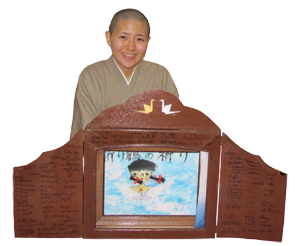Kamishibai, made from the two Japanese words for “paper” and “drama”, is a form of Japanese storytelling, originally from the Japanese Buddhist temples of the 12th century. Usually a storyteller sits behind or to the side of a small, free standing stage, while pictures on the stage are used to tell a story. Each picture has writing on the back, to be read out over each subsequent picture.
We would therefore like to invite you to a series of Kamishibai events taking place in Southampton and Cardiff in September, presented by Maki Saji, a 24yr old nun from the Myozoji Buddhist Temple at Izu Peninsula in Japan.
There are 4 dates as follows:
19/09/11 University of Southampton 5:30pm
21/09/11 Wales Millennium Centre 12:30pm
22/09/11 Caerleon Town Hall 7:30pm
24/09/11 Canton Uniting Church, Cardiff 7:30pm
The tickets are free of charge, but please book in advance to avoid disappointment.
Enquiries should be made to:
Suiohkai at qwyrdd@ma.kew.net or
Telephone 029 2069 1803.
The event poster can be viewed or downloaded HERE.
Tower of a Thousand Cranes
The story being told is called “Tower of a Thousand Cranes” and recounts the tale of Sadako Sasaki who, at the age of two, was one of the many children whose world was pulled apart by the atomic bomb raid on Hiroshima in 1945. Though she had been left uninjured by the explosion, she died of leukaemia 10 years later. In 1953, when she was hospitalised, she started making 1000 origami paper cranes, praying that her wish would be granted for good health and a full recovery. She died however, two years later at the age of 12.
The Children’s Peace Monument in Hiroshima, also known as the Tower of a Thousand Cranes, was unveiled in the Peace Memorial Park in 1958 as a memorial to Sadako Sasaki, and stands today as a silent symbol for peace and harmony. The monument houses a 9m bronze statue of Sadako holding a golden crane over her head. The monument gathers over ten million cranes each year, and innumerable colourful cranes adorning the walls have now become a symbol for peace all across the globe.
To enable more people to know about Sadako, Maki Saji created a kamishibai based on the story and the 1000 origami cranes, and she has presented it around the world.
Her message is simple: to highlight the misery and futility of war, and the importance of life itself.



Comments
4 responses to “Invitation to a Kamishibai”
I live in Shizuoka Prefecture, Japan. I happened to find this site, searching for “Peace Crane Kamishibai”.
“Peace Crane Kamishibai” is the title of a newly published book which my friend and I wrote about Maki Saji and her performance of peace kamishibai. It is an English book mainly for students who learn English. My friend and I wrote the book by interviewing Maki many times.
When I visited Maki on August 26, I heard that she would visit UK and perform her kamishibai. Thank you for inviting her. She said she would take some copies of “Peace Crane Kamishibai”. I hope you and many people will read it. You will find what has made Maki perform peace kamishibai so enthusiastically.
I hope her kamishibai show will be successful. I look forward to hearing from you.
Sincerely,
Takako
I hope my e-mailwill reach you.
Takako
I went to Maki Saji last night and I was so beautifully moved by the story and the presentation. It was an honour to be there!
The audience participated in making cranes, which will be taken to Maki’s next destination in Washington, USA. A truly beautiful story of hope and remembering the strength and love of Sadako Sasaki, a very inspiring young girl..
I would recommend this opportunity to everyone..
21 September 2011
International Peace Day.
I attended the Kamishibai “1000 Origami Cranes for World Peace ” presented by Maki Saji today in Cardiff Wales UK.
It was an honour to speak with her in my very limited Japanese. Her smile portrayed a thousand words.
Having visited the Children’s Peace Monument in Hiroshima, hearing the story of little Sadako Sasaki related so beautifully by Maki Saji with translation in to English by Miss Midori Matsui, was so poignant, but a true story full of HOPE and LOVE. It was a privilige to be part of the audience. We each made paper cranes which will be taken to America next year.
May the message of peace and harmony reach the hearts of all peoples of all nations.
As many people as possible should see this wonderful performance.